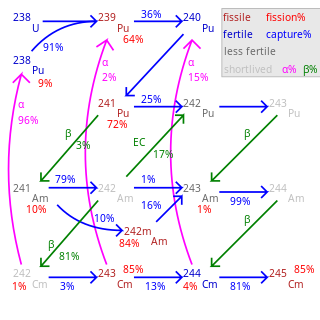Plutonium-242
Isotope of plutonium From Wikipedia, the free encyclopedia
Plutonium-242 (242Pu or Pu-242) is the second longest-lived isotope of plutonium, with a half-life of 375,000 years. The half-life of 242Pu is about 15 times that of 239Pu; so it is one-fifteenth as radioactive, and not one of the larger contributors to nuclear waste radioactivity. 242Pu's gamma ray emissions are also weaker than those of the other isotopes.[1]
| General | |
|---|---|
| Symbol | 242Pu |
| Names | plutonium-242, 242Pu, Pu-242 |
| Protons (Z) | 94 |
| Neutrons (N) | 148 |
| Nuclide data | |
| Half-life (t1/2) | 375000 years |
| Isotope mass | 242.059 Da |
| Decay products | 238U |
| Decay modes | |
| Decay mode | Decay energy (MeV) |
| Isotopes of plutonium Complete table of nuclides | |
It is not fissile (but it is fissionable by fast neutrons), and its neutron capture cross section is low.
In the nuclear fuel cycle
Summarize
Perspective

Plutonium-242 is produced by successive neutron capture on 239Pu, 240Pu, and 241Pu. The odd-mass isotopes 239Pu and 241Pu have about a 3/4 chance of undergoing fission on capture of a thermal neutron and about a 1/4 chance of retaining the neutron and becoming the following isotope. The proportion of 242Pu is low at low burnup but increases nonlinearly.
242Pu has a particularly low cross section for thermal neutron capture; and it takes three neutron absorptions to become another fissile isotope (either curium-245 or plutonium-241) and then one more neutron to undergo fission. Even then, there is a chance either of those two fissile isotopes will absorb the fourth neutron instead of fissioning, becoming curium-246 (on the way to even heavier actinides like californium, which is a neutron emitter by spontaneous fission and difficult to handle) or becoming 242Pu again, so the mean number of neutrons absorbed until fission is even higher than 4. Therefore, 242Pu is particularly unsuited to recycling in a thermal reactor and would be better used in a fast reactor where it can be fissioned directly. However, 242Pu's low cross section means that relatively little of it is transmuted during one cycle in a thermal reactor.
Decay
Summarize
Perspective
| Actinides[2] by decay chain | Half-life range (a) |
Fission products of 235U by yield[3] | ||||||
|---|---|---|---|---|---|---|---|---|
| 4n | 4n + 1 | 4n + 2 | 4n + 3 | 4.5–7% | 0.04–1.25% | <0.001% | ||
| 228Ra№ | 4–6 a | 155Euþ | ||||||
| 248Bk[4] | > 9 a | |||||||
| 244Cmƒ | 241Puƒ | 250Cf | 227Ac№ | 10–29 a | 90Sr | 85Kr | 113mCdþ | |
| 232Uƒ | 238Puƒ | 243Cmƒ | 29–97 a | 137Cs | 151Smþ | 121mSn | ||
| 249Cfƒ | 242mAmƒ | 141–351 a |
No fission products have a half-life | |||||
| 241Amƒ | 251Cfƒ[5] | 430–900 a | ||||||
| 226Ra№ | 247Bk | 1.3–1.6 ka | ||||||
| 240Pu | 229Th | 246Cmƒ | 243Amƒ | 4.7–7.4 ka | ||||
| 245Cmƒ | 250Cm | 8.3–8.5 ka | ||||||
| 239Puƒ | 24.1 ka | |||||||
| 230Th№ | 231Pa№ | 32–76 ka | ||||||
| 236Npƒ | 233Uƒ | 234U№ | 150–250 ka | 99Tc₡ | 126Sn | |||
| 248Cm | 242Pu | 327–375 ka | 79Se₡ | |||||
| 1.33 Ma | 135Cs₡ | |||||||
| 237Npƒ | 1.61–6.5 Ma | 93Zr | 107Pd | |||||
| 236U | 247Cmƒ | 15–24 Ma | 129I₡ | |||||
| 244Pu | 80 Ma |
... nor beyond 15.7 Ma[6] | ||||||
| 232Th№ | 238U№ | 235Uƒ№ | 0.7–14.1 Ga | |||||
| ||||||||
242Pu alpha decays into uranium-238, before continuing along the uranium series. 242Pu decays by spontaneous fission in about 5.5 × 10−4% of cases.[7]
References
Wikiwand - on
Seamless Wikipedia browsing. On steroids.